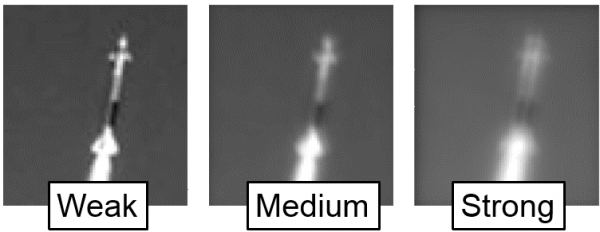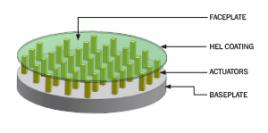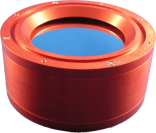INTRODUCTION
It’s hard to imagine a part of the military that does not use some kind of optical system to achieve its mission objectives. Optical systems are used throughout the Services for surveillance, rifle scopes, laser weapons, laser designators, and night vision goggles. And these systems would be used even more if they were lower in cost and offered better performance. Unfortunately, optical manufacturing techniques are expensive because achieving the high precision required for the desired optical performance requires increased manufacturing time. Without significant machine time, optics produced are warped such that their interaction with light causes the system performance to degrade. Accordingly, for the past several decades, industry has been working on developing adaptive optics (AO) technology to combat the performance limitations and enable these aberrations to be fixed.
THE OPTICAL ABERRATION PROBLEM
Optical aberrations have been degrading optical system performance even before mankind invented optics—hence the need for human eyeglasses. In modern optical systems, optical aberrations are caused by manufacturing imperfections, material imperfections, environmental effects on the optics (such as nonuniform heating and cooling), and even the air in and around the optical system. Some of these problems can be addressed with proper optical engineering and manufacturing, but some cannot. Even though AO could be used to improve systems with manufacturing imperfections, the focus herein is on the aberrations that are not able to be addressed by common engineering techniques.
For example, surveillance telescopes used to achieve both space and battlefield awareness look through the atmosphere, which is in a constant state of flux as hot and cold air mix together, especially near the surface of the earth. These pockets of hot and cold air have different refractive indices and therefore bend the light as it passes through them. This effect is what causes stars in the sky and lights in the distance to appear to twinkle at night. It also is the cause of the mirage effect that can be seen on hot days over asphalt roads. The pupil of the human eye is small enough that our visual system and most of our smaller cameras are not significantly impacted by these atmospheric optical aberrations. In most conditions, air turbulence is only a problem if the diameter of the collection optic exceeds about 10 cm, but longer-range imaging and laser delivery systems require these larger optics to achieve high precision at a distance (see Figure 1).

Figure 1: The Effect of Different Strength Turbulence on the Image of a Rocket.
THE AO SOLUTION
AO is an engineering solution to addressing these aberrations. It is essentially the optical equivalent to noise-cancelling headphones, wherein a small microphone measures the sound waves impinging on the headphone and broadcasts a sound wave exactly out of phase with it into the wearer’s ear to minimize the noise perceived by the ear. In the most common AO system architecture, a special camera called a wavefront sensor is used to detect the internal or external aberrations induced on a beam of light. Then a device called a deformable mirror (DM) is used to bend the light in the opposite way that the aberrations bent it and cancel out their effect. This technique of optically engineering the light was published by astronomer Horace Babcock in 1953 but required significant component development to mature the concept into functioning systems, which were demonstrated in the 1970s.
Since the first demonstrations of AO, there have been some key advances in technology that make it more appealing for commercial and government applications. In 1971, Roland Shack and Ben Platt published an improvement to the Hartmann sensor that replaced the array of apertures with an array of lenses, thus increasing the optical efficiency, putting the detector in the exact far-field of the incident radiation, and making the sensor practically insensitive to intensity fluctuations in the input plane. This development was important because it made the wavefront detector able to see light from the target at a larger distance. In addition, it made the detector more effective at measuring the wavefront of light after the propagation through the aberrating atmosphere caused the intensity to change due to scintillation.
In the 1970s, Itek Corporation began making versions of the modern DM [1]. These DMs were able to respond faster than the Eidophor proposed by Babcock and were more optically efficient. In the 1990s, Mansell and his colleagues at Stanford University developed silicon-based micro electromechanical system (MEMS) DMs and wavefront sensors based on complementary metal-oxide-semiconductor (CMOS) imagers, enabling both mass fabrication and a significant increase in speed [2]. Of course, throughout this time, microprocessor and field-programmable gate array (FPGA) technology developed considerably, making practical the processing of the massive amount of data received from a wavefront sensor required to control the DM.
In 2006, MZA Associates Corporation became aware of some performance and manufacturability challenges associated with DM technology that were hindering the development of high-power solid-state lasers. DMs were failing under the high power levels due to heating and point defects in the evaporated coatings. Replacement DMs were quoted with estimated 9–12-month production times. However, MZA was able to demonstrate, with prototypes, high-power DMs (as shown in Figure 2) within 6 weeks. Both DMs survived high-power laser testing but had some residual absorption in the surface due to the electron-beam evaporated coatings.
Following the prototype development, the manufacturing process was adapted to enable the use of annealed ion-beam sputtered (IBS) coatings, thereby reducing the absorption in the coating from approximately 20 ppm to 0.4 ppm. This 40× reduction in coating absorption resulted in a DM that could withstand significantly more laser power before heating and damage became a concern.
The first IBS-coated DM was tested in a high-power laser system with 120-kW average power for 5 s and <1 °C heating on the surface when observed by a thermal camera. In the same test, there was no distortion on the surface on an over-resolved (>1 subaperture per DM actuator) Shack-Hartmann wavefront sensor due to this heating. Subsequent testing on a DM coated for reflectivity at 1,064 nm, 1,550 nm, and 532 nm survived an irradiance of >1 MW/cm2 when illuminated by a 10-kW average power laser for 30 s. This high-irradiance test showed no localized heating on the silicon mirror surface.
Figure [EMF1] 2: The Basic Architecture of a Surface Normal Plate-Type DM and Prototype[ee2] .
These DMs and drive electronics are meeting or exceeding the current requirements of the AO community. Typical MZA DMs have a 3-dB performance bandwidth of 10 kHz, which is well beyond the typical Greenwood frequency requirement of the atmosphere. Further, these DMs have been flattened to a root mean square (RMS) surface figure of less than 2% of an optical wavelength, and the respective drive electronics have a digital latency of less than 10 µs, enabling high-bandwidth wavefront control.
After demonstrating high-power handling capability, MZA proceeded to address several other performance challenges that were plaguing the industry. DMs in AO systems act like a filter, removing all the wavefront distortion at spatial frequencies below the spatial period equal to double the actuator spacing. Unfortunately, some of the older DM designs were inducing a residual wavefront warp at the spatial period equal to the actuator spacing due to heating (mismatch in differential thermal expansion) and internal stresses. This higher-order residual was sometimes leaving the wavefront with a distortion that dramatically limited the efficacy of the AO system. MZA developed a new architecture of DM that reduced this higher-order warp significantly, thereby making the AO system much more effective at wavefront compensation.
These new DMs use lead zirconate titanate (PZT) actuators because of their high efficiency, high reliability, and stable performance over a wide temperature range. DMs with up to 18 µm of physical stroke using only 120 V have been successfully demonstrated. Unfortunately, PZT actuators have 12% hysteresis at room temperature, which makes the control of a DM more difficult. But MZA has manufactured a set of drive electronics that demonstrated a reduction of hysteresis to 7%, thereby enabling faster and more reliable wavefront control.
CONCLUSION
AO technology is currently undergoing a transition from a research curiosity used only in high-end telescopes and military systems to an emerging technology that is being adopted in a wider range of applications. Commercial industry is now building demonstrator systems using DMs to shape the laser beam intensity profile on target, making more efficient and effective laser machining systems. And both commercial and military imaging systems are being demonstrated with AO to enhance performance in virtually everything from microscopes to surveillance systems. In the future, as DM and AO component and system performance continues to be improved and associated costs reduced, these technologies are expected to be increasingly adopted in new optical systems, enabling users to truly get the best out of light with AO.
References:
- Hardy, J. W. “Real-Time Wavefront Correction System.” U.S. Patent 3,923,400, 1975.
- Mansell, J. D., P. B. Catrysse, E. K. Gustafson, and R. L. Byer. “Silicon Deformable Mirrors and CMOS-Based Wavefront Sensors.” SPIE Proceedings, vol. 4124, 2000.




